Noctua NH-D15 versus Phanteks PH-TC14PЕ: Great Combat

Austrian Noctua fans were a long waiting of update to flagship NH-D14 cooler. Finally the successor has arrived. Does the new Noctua NH-D15 fully answer to expectations?
About five years ago the Austrian firm Noctua released its super-cooler NH-D14. It turned out to be extremely good and took a leading position among the best of CPU coolers. Even today, periodically acquiring new fastening mechanisms to support the latest PC platforms, it can easily beat many new products, including comparably priced ready-made liquid cooling systems. But nothing is permanent, especially super-coolers.
So now the NH-D14 is going to be replaced by the NH-D15 model announced a month ago. The newer version is not a dramatic overhaul, yet features certain optimizations for higher performance and better compatibility. It’s got larger and faster fans, too. In this review we’re going to take a closer look at Noctua’s latest product.
Specifications and Recommended Price
The Noctua NH-D15 specs are listed in the following table in comparison with its predecessor NH-D14.
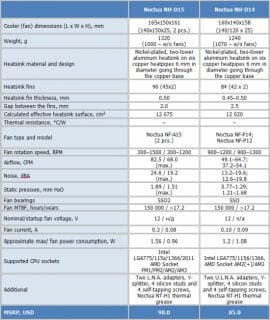
Packaging and Accessories
The cardboard packaging with the new cooler has become larger, yet the overall design is the same as with the previous model. The box is mostly brown with an addition of some white.
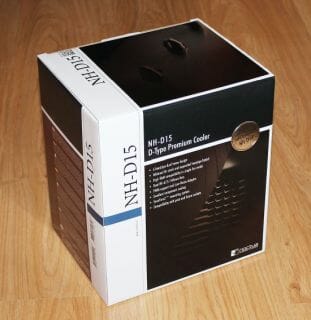
There’s a lot of information on the box about the cooler’s specs, key features, supported platforms, etc.
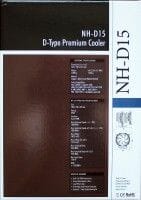
The product is protected well on its way to the customer. The cooler’s heatsink and fan are packed into a cardboard wrap amidst sheets of foam rubber.
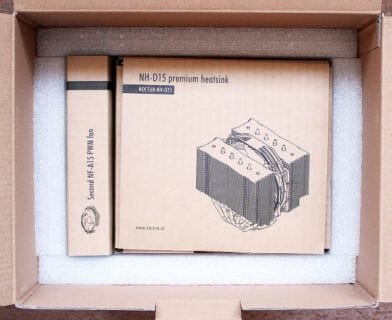
We guess there should be no problems during transportation. That’s quite important, by the way. We’ve seen a lot of damaged boxes with coolers, sometimes even with crumpled heatsinks inside.
There are additional small boxes with accessories and fasteners for AMD and Intel platforms.
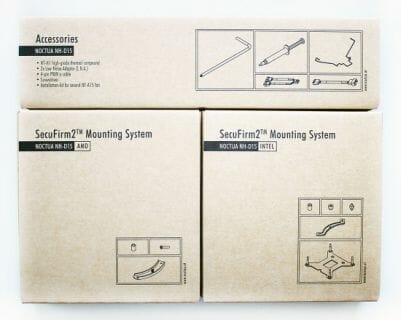
The accessories haven’t changed much since the Noctua NH-D14 except for the improved fasteners and back-plate.
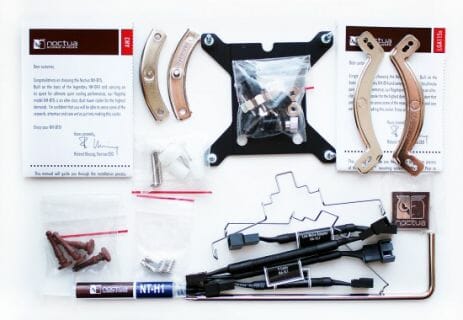
The cooler comes with high-efficiency Noctua NT-H1 thermal grease, which is expected to last for 15 applications.
The Noctua NH-D15 is manufactured in Taiwan and comes with a 6-year warranty. It costs $90, which is $5 higher than the recommended price of the NH-D14 model.
Design Features
The Noctua NH-D15 hasn’t changed in design since the previous version. It is still a dual-tower cooler with two fans, one of which is installed between the two heatsink sections.
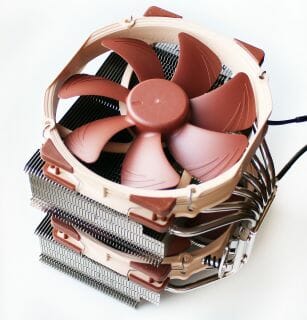
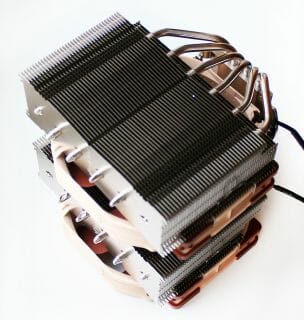
The new model is 5 mm taller and 10 mm wider than its predecessor but 3 mm smaller in depth. The weight has increased from 1240 to 1320 grams but the heatsink is lighter (1000 as opposed to the previous model’s 1070 grams). The larger weight is due to the bigger fans.
Each heatsink section is pierced by six nickel-plated copper heat pipes. Interestingly, the ends of the outermost pipes are placed lower than the others.
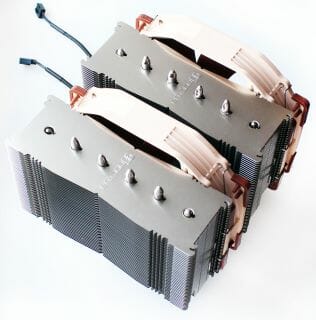
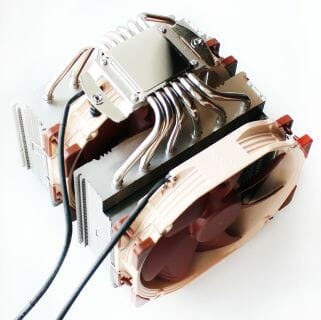
The Noctua NH-D14 had an asymmetric heatsink in which one section was farther from the central axis of its base, but the new model’s heatsink sports full symmetry.
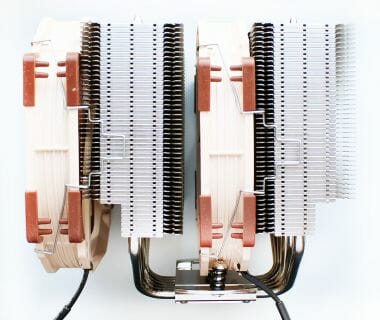
Each heatsink section consists of 45 aluminum fins, 0.5 mm thick and 2.0 mm apart from each other. The seven bottommost fins in each section are narrower: 30 instead of 50 mm. This is done to make the heatsink more compatible with tall memory modules, although it can hardly help if you install an external fan.
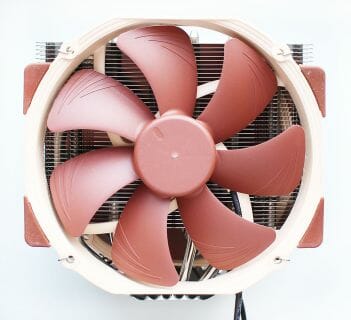
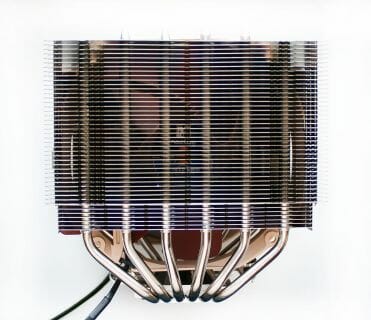
The heat pipes go through the heatsink sections along the central axis and are positioned wider apart than in the Noctua NH-D14.
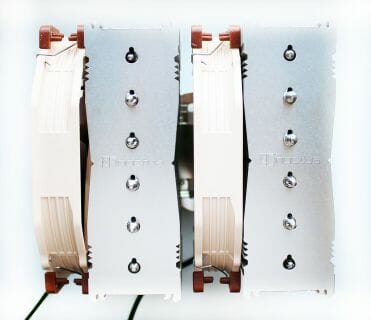
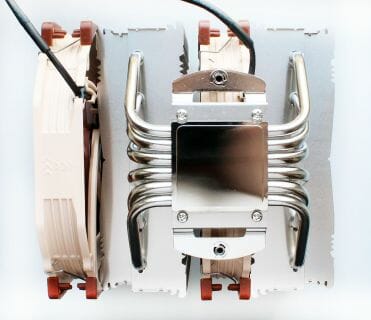
The heatsink’s total heat dissipation area is 12,075 sq. cm, similar to that of the NH-D14 model. To optimize the air flow, each heatsink section has a wedge-shaped depression while the ends of the fins have a wavy profile.
The pipes are partially soldered to the fins.
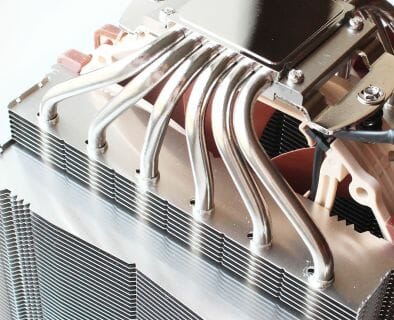
The heat pipes are also neatly soldered to the cooler’s nickel-plated copper base. They are placed in grooves about 1 mm apart from each other.
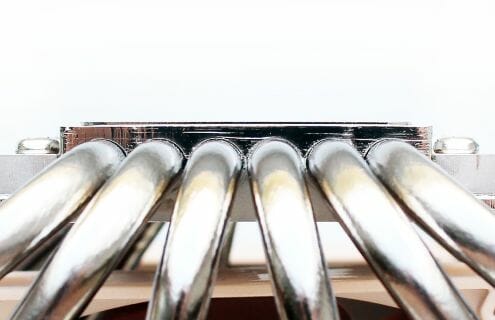
The base is finished well, but not to a mirror shine.
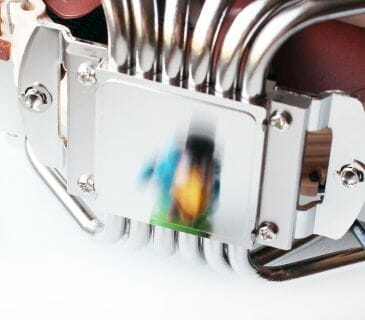
It is 40×39 mm large and perfectly flat, so we’ve got a perfect thermal grease imprint with our LGA2011 processor.
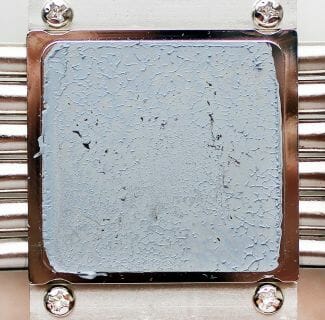
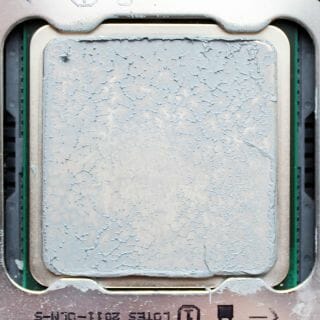
The Noctua NH-D14 used to be equipped with one 120mm and one 140mm fan whereas the new model features two state-of-the-art NF-A15 PWM fans we tested last year and were highly pleased with.
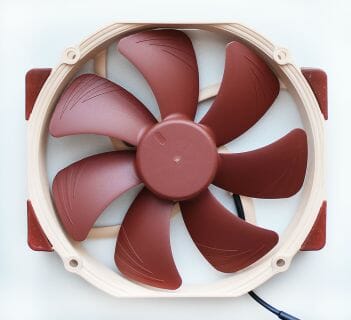
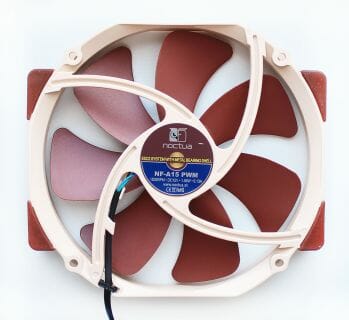
The fan features a number of exclusive technologies to improve air flow and reduce noise. We won’t dwell upon them here, though. We can only tell you that the NH-D15 uses an accelerated version of the NF-A15 PWM fan which can work in a speed range of 300 to 1500 RPM or 300 to 1200 RPM with the inline resistor cable. The peak noise level of each fan is specified at 24.6 dBA.
The SSO2 bearings have a service life of 150,000 hours (over 17 years) of continuous operation.
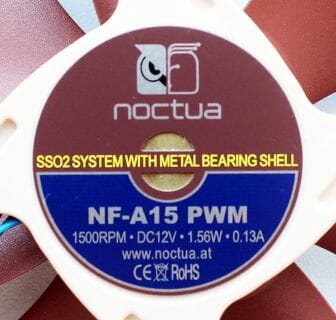
The peak power draw of each fan is a little above 1.5 watts. The fans are fastened to the heatsink with wire brackets you insert into the openings in the fan’s frame and into the side slits in the heatsink’s sections. The heatsink being symmetrical and having such slits in each side of each section, the Noctua NH-D15 theoretically supports three fans simultaneously, but there’s no additional pair of brackets among the cooler’s accessories.
Compatibility and Installation
The Noctua NH-D15 is a top-end air cooler, so it goes without saying that it is compatible with every PC platform from both Intel and AMD. You only need to make sure it can fit into your computer case.
The installation procedure is detailed in the user guide. The Noctua SecuFirm2 fastening mechanism is considered among the best and handiest, so it hasn’t changed much over the years. To install an NH-D15 on an LGA2011 mainboard, you insert four threaded pins into the mounting holes of the CPU socket’s fastening plate.
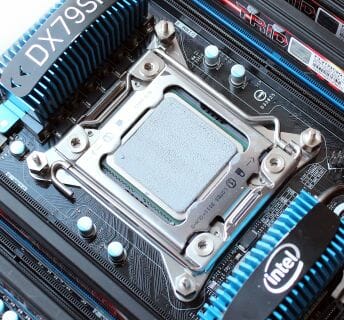
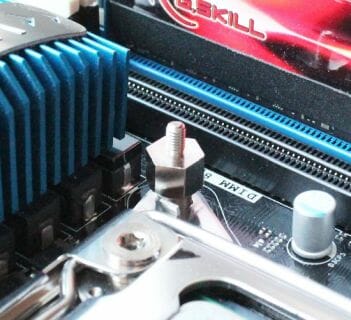
Then you secure two steel guides on those pins.
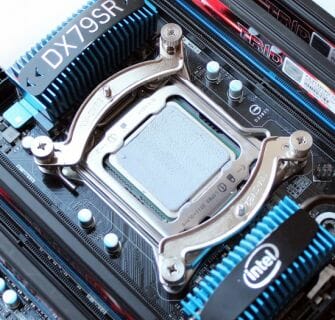
After that you just mount the heatsink on your CPU and secure it with spring-loaded screws using a cross-point screwdriver.
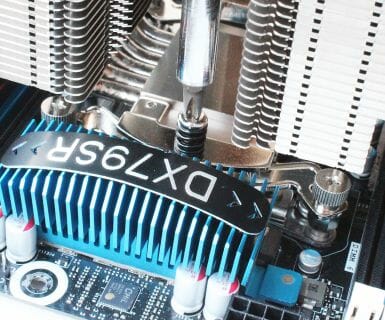
That’s all, actually. Then you just hang fans on the heatsink, fastening them with wire brackets and connecting them via a Y-shaped splitter to one of your mainboard’s 4-pin fan connectors.
There’s a distance of over 50 mm between the heatsink’s bottommost fin and the mainboard. The broader fins are an additional 20 mm higher, so the Noctua NH-D15 is going to be compatible with tall memory modules unless you use an external fan. When we did, we found the fan to conflict with the 40mm heatsinks of our G.Skill TridentX F3 modules.
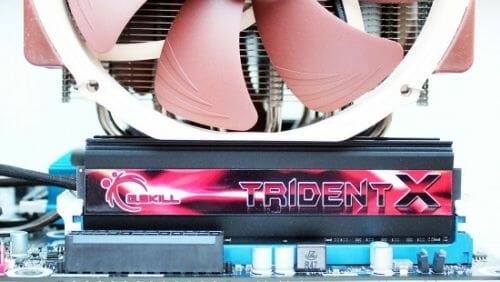
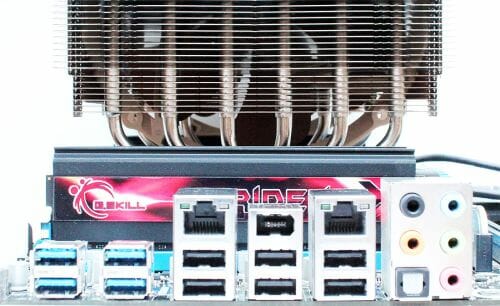
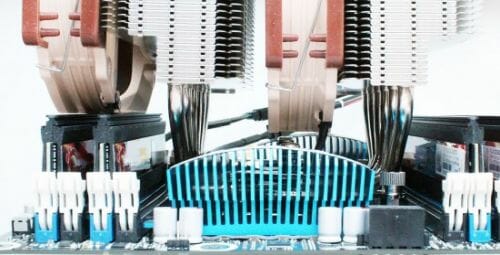
Placing this fan higher on the heatsink would make the cooler taller and less efficient in terms of performance.
When installed, the Noctua NH-D15 can hardly be told from a Noctua NH-D14.
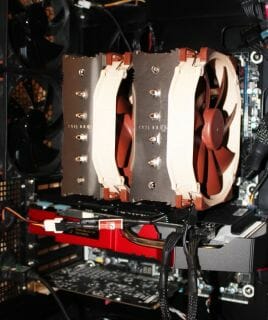
The installed cooler is 168 mm tall, which is quite normal for its class.
Overall, the NH-D15 brings about fewer innovations that expected. Now let’s check out its performance and noise level in comparison with the current leader among air coolers as well as some other products.
Testbed and Methods
We tested all coolers in a closed system case that had the following configuration:
- Mainboard: Intel Siler DX79SR (Intel X79 Express, LGA2011, BIOS 0594 dated 06.08.2013)
- CPU: Intel Core i7-3970X Extreme Edition 3.5/4.0 GHz (Sandy Bridge-E, C2, 1.1 V, 6x256KB L2 cache, 15MB L3 cache)
- Thermal grease: ARCTIC MX-4
- Graphics card: AMD Radeon HD 7770 GHz Edition (1GB GDDR5, 128-bit, 1000/4500MHz, with a passive copper heatsink from the Deepcool V4000 cooler)
- System memory: DDR3 4x8GB G.SKILL TridentX F3-2133C9Q-32GTX (XMP: 2133 MHz, 9-11-11-31, 1.6 volts)
- System disk: SSD 256GB Crucial m4 (SATA 6 Gbit/s, CT256M4SSD2, BIOS v070H)
- Games/software disk: Western Digital VelociRaptor (SATA-2, 300 GB, 10000 RPM, 16 MB cache, NCQ) in a Scythe Quiet Drive 3.5″ enclosure
- Backup disk: Samsung EcoGreen F4 HD204UI (SATA-2, 2 TB, 5400 RPM, 32 MB cache, NCQ)
- Sound card: Auzen X-Fi HomeTheater HD
- Computer case: Antec Twelve Hundred (front panel: three Noiseblocker NB-Multiframe S-Series MF12-S2 fans at 1020 RPM; back panel: two Noiseblocker NB-BlackSilentPRO PL-1 fans at 1020 RPM; top panel: one preinstalled 200mm fan at 400 RPM)
- Control & monitoring panel: Zalman ZM-MFC3
- Power supply: Corsair AX1200i (1200 W), 120mm fan
- Monitor: 27″ (DVI-I, 2560×1440, 60 Hz)
For our today’s tests we overclocked our six-core processor to 4.4 GHz with the base clock rate set at 100 MHz, the CPU frequency multiplier at x44 and Load-Line Calibration enabled. The CPU voltage was increased to 1.240~1.245 volts in the mainboard’s BIOS. Turbo Boost was disabled whereas Hyper-Threading technology was enabled to increase heat dissipation. The system memory had a voltage of 1.6125 volts and a frequency of 2133 MHz with timings of 9-11-11-20_CR1. All other CPU and memory-related options were left intact in the mainboard’s BIOS.
We carry our tests out in Microsoft Windows 7 Ultimate x64 SP1 using the following software:
- LinX AVX Edition version 0.6.4 – to load the CPU (memory – 4500 MB, Problem Size – 24234, two 11-minute cycles)
- Real Temp GT version 3.70 – to monitor the temperature of the CPU cores
- Intel Extreme Tuning Utility version 4.2.0.8 – for monitoring the overclocked system
Here is a screenshot of the system during our test session:
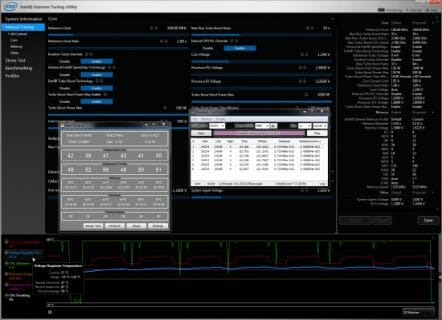
To load our CPU, we run the LinX AVX test with the above-indicated settings in two cycles. There is a pause of 8-10 minutes between the cycles for the CPU temperature to stabilize. The end results are the highest temperature of the hottest CPU core at peak load and in idle mode. Moreover, we’ll show you temperature data for all CPU cores in a separate table. The room temperature was monitored with an electronic thermometer. It varied from 22.2 to 22.7°C during this test session.
We measured the level of noise using an electronic noise-level meter CENTER-321 in a closed and quiet room about 20 sq. meters large. The noise-level meter was set on a tripod at a distance of 15 centimeters from the cooler which was installed on an open testbed. The mainboard with the cooler was placed at an edge of a desk on a foam-rubber tray. The bottom limit of our noise-level meter is 29.8 dBA whereas the subjectively comfortable (not low, but comfortable) level of noise when measured from that distance is about 36 dBA. The quiet level of noise is about 33 dBA. The speed of the cooler’s fans was being adjusted by means of a controller that changed the supply voltage in steps of 0.5 V.
We will compare the Noctua NH-D15 with the Phanteks PH-TC14PЕ ($75-80), which is the best air cooler we’ve tested so far. The latter is tested with its two default fans as well as with two Noctua NF-A15 PWM fans.
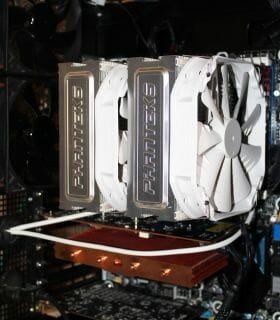
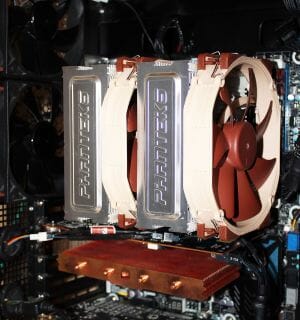
Moreover, we also tested the Phanteks PH-TC14PЕ with two Corsair AF140 Quiet Edition fans.
The speed of each cooler’s fans was regulated via a dedicated controller from 800 RPM to the maximum with a step of 200 RPM.
Cooling Performance
The test results of the two air coolers are listed in the table and diagram below:
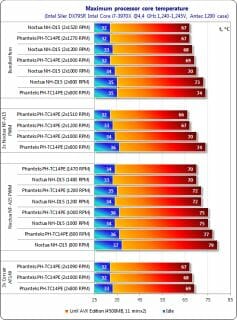
Working with its default fans, the Noctua NH-D15 is as efficient at 1520 RPM as the Phanteks PH-TC14PЕ at 1270 RPM. When the speed of the fans is reduced to 1000 and 800 RPM, the Phanteks PH-TC14PЕ is ahead of the Noctua NH-D15 by 1°C at peak load. Considering the measurement accuracy, the two coolers seem to be nearly identical in performance with their default fans.
When the Phanteks PH-TC14PЕ is equipped with a couple of Noctua NF-A15 PWM fans, it goes 1°C ahead of the Noctua NH-D15 at 1510 and 1200 RPM and enjoys the same 1°C advantage at 1000 and 800 RPM. And leaving only one NF-A15 PWM fan in the center of the coolers’ heatsinks, we again see them perform identically. It is only at 800 RPM that the Phanteks PH-TC14PЕ wins by a couple of degrees at peak load.
The two Corsair AF140 fans work wonders with the Phanteks heatsink in the quiet 800RPM mode, surpassing the Noctua and Phanteks heatsinks by 5°C at the same speed. That’s impressive.
Now we overclock our CPU to 4.6 GHz and increase its voltage to 1.300-1305 volts and rerun our tests except for the single-fan mode. Here are the results.
Although the Noctua NH-D15 wins at the maximum speed of the default fans, the Phanteks PH-TC14PЕ enjoys a 1 or 2°C advantage at each other speed: 1200, 1000 and 800 RPM. Installing Noctua fans on the Phanteks PH-TC14PЕ improves the latter’s performance a little, so it seems to be slightly better than the Noctua NH-D15 with identical fans. It is the Corsair AF140 fans that are the best choice for the Phanteks PH-TC14PЕ, though.
The following table* and diagram list all coolers we’ve tested so far (in their default configurations) as they cool our CPU overclocked to 4.4 GHz at a voltage of 1.240~1.250 volts.
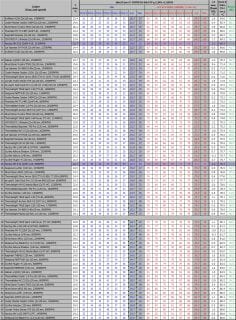
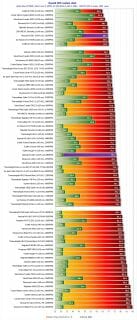
At the maximum speed of the fans the Noctua NH-D15 joins the elite club of air and ready-made liquid cooling systems which includes such products as CRYORIG R1 Ultimate, Raijintek Nemesis, Ice Hammer IH-THOR and, of course, Phanteks PH-TC14PЕ. And the Noctua NH-D15 is not the noisiest among them. In the quiet mode (with its two fans working at 800 RPM) it is in the middle of the second group but takes a leading position in terms of noise level.
Using the Noctua NH-D15 with its default fans at maximum speed, we then tried to overclock our CPU as hard as we could. As a result, our six-core Intel i7-3970X Extreme Edition was stable at 4700 MHz and 1.340 volts, the peak temperature of its hottest core being 83°C.
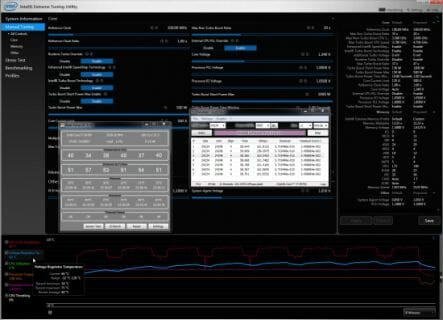
We write this result down into our summary table and diagram:
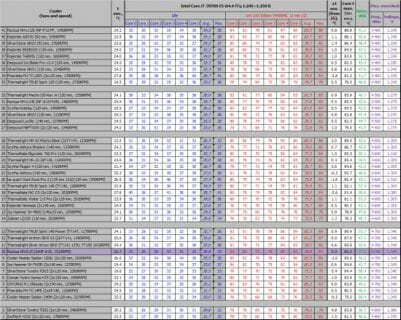
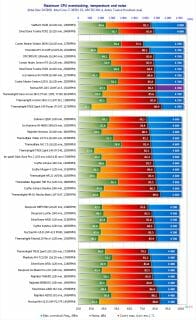
That’s a really good but expected result. Now let’s check out the new cooler’s noisiness.
Noise Level
Here the results of our noise level test we carried out following the method explained in the Testbed and Methods section of our review.
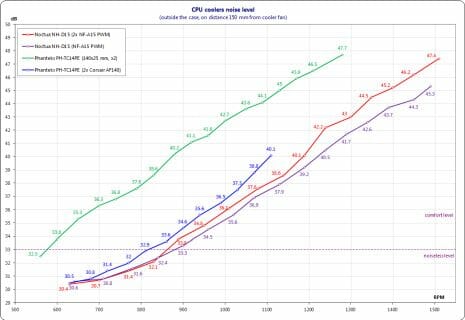
The Phanteks PH-TC14PЕ is somewhat better than the Noctua NH-D15 in terms of cooling performance but falls behind the new Austrian flagship in terms of noisiness – when both use their default fans. The difference is huge: the Noctua’s fans are subjectively comfortable up to 1000 RPM whereas the Phanteks’s up to 700 RPM only. These coolers are quiet at 850 RPM for the Noctua NH-D15 and 570 RPM for the Phanteks PH-TC14PЕ. We guess it’s obvious which one is going to be more efficient if both are set to the same noise level.
Removing the external fan from the Noctua NH-D15 helps lower the noise by a few dBA more at speeds of 840 RPM and higher. And we have no doubts about the quality of Noctua’s fans. They are going to serve long and be as quiet as in their out-of-box state.
Conclusion
Carrying on the glorious traditions of the famous Noctua NH-D14, the NH-D15 model is worthy of its predecessor’s fame and deserves the status of a super-cooler. Having got a little broader, taller, heavier and costlier, the NH-D15 can compete with the best products of its class and help you squeeze everything possible out of your CPU at overclocking. Although we didn’t compare it with the NH-D14 in our tests, we guess that the new model largely owes its high performance to the new NF-A15 PWM fans. The heatsink has only been modified to make it compatible with tall heatsinks on memory modules. The heatsink’s total area, the thickness of its fins and the number of heat pipes have remained the same. The fastening mechanism is the same, too, just because it was already perfect. So, even though the Noctua NH-D15 is a super-cooler with fantastically quiet fans, we are still left a little disappointed. After five years the Austrian engineers might have pleased us with something more than simple restyling. We are sure they can do that, but time will show.